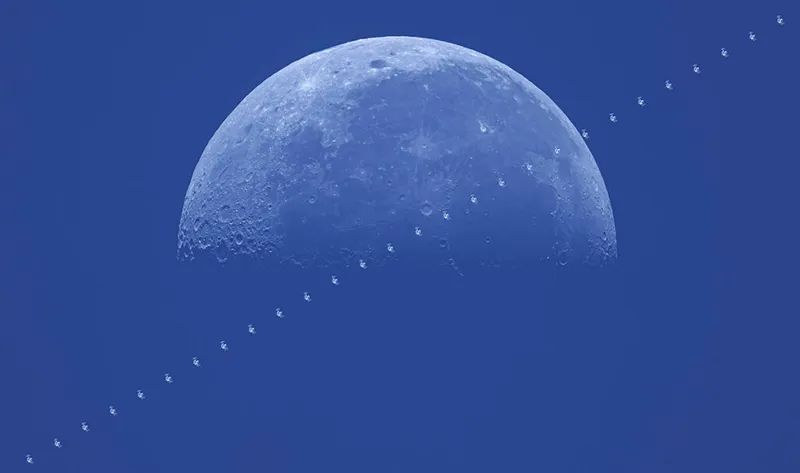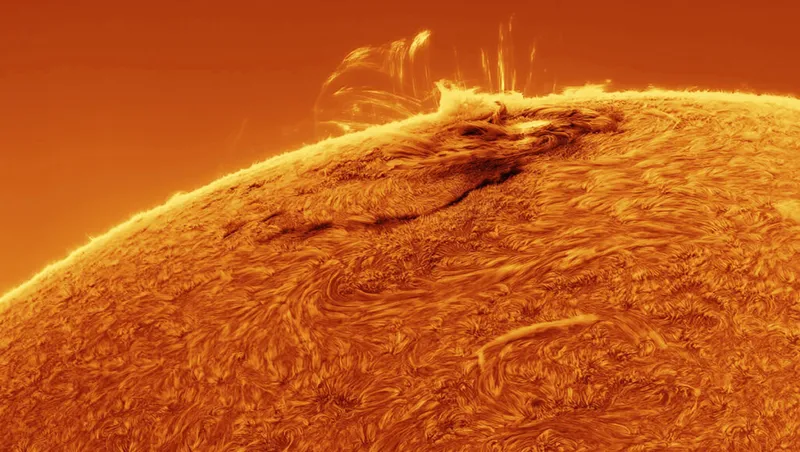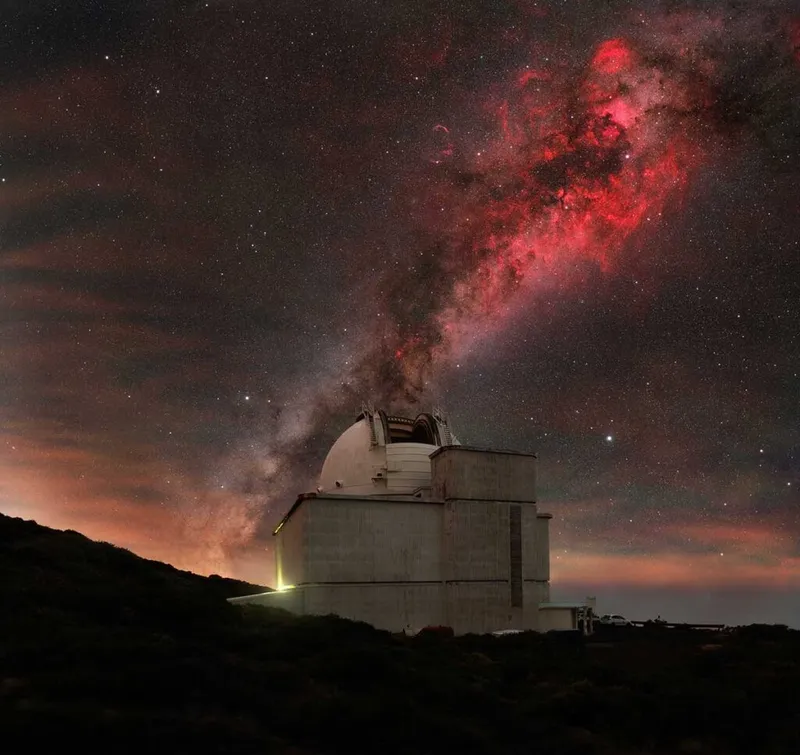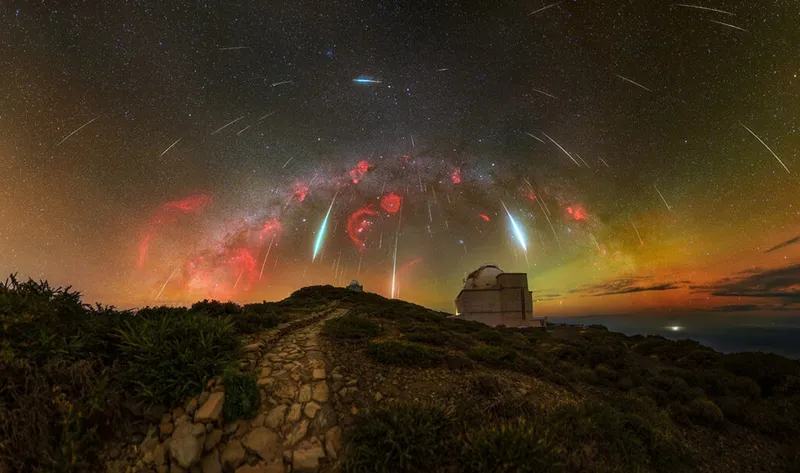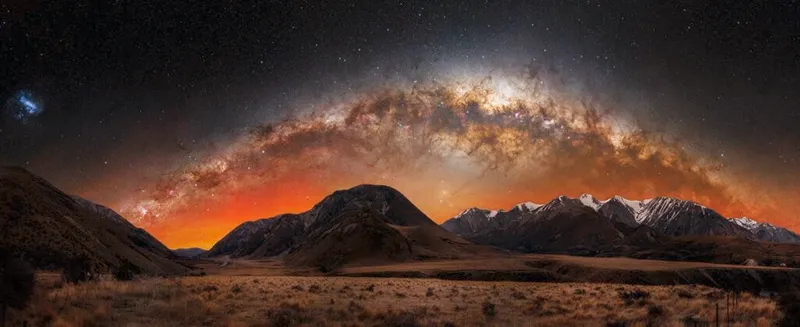The shortlisted images from the Astronomy Photographer of the Year 2024 competition have been released by the Royal Observatory Greenwich.
Among this year’s shortlisted entries are dazzling displays of aurorae, ancient galaxies, views of our Milky Way galaxy stretching across the night sky, an explosive meteor shower display, cosmic clouds and the International Space Station passing in front of the Moon.
The International Space Station Daytime Moon Transit © Kelvin Hennessy (Australia). Category: Our Moon. Taken with a Saxon ED127 FCD100 Triplet Refractor telescope, Baader IR/UV filter, Sky-Watcher EQ6-R mount, ZWO 294MC Pro camera, 952 mm f/7.5, Gain 192, 1-millisecond exposure. Location: Gold Coast, Queensland, Australia, 3 February 2024 Now in its 16th year, Astronomy Photographer of the Year is the biggest astrophotography competition in the world, and in 2024 received over 3,500 entries from 58 countries across the globe.
Entrants can submit images across a range of categories including People & Space; Planets, Comets & Asteroids; Our Sun; Our Moon; Aurorae; and Stars & Nebulae.
Special prizes include the Sir Patrick Moore Prize for Best Newcomer and the Anne Maunder Prize for Image Innovation, the latter marking the work of image processors manipulating raw space mission data.
And Young Astronomy Photographer of the Year celebrates the work of astro imagers under the age of 16.
Arctic Dragon © Carina Letelier Baeza (Chile). Category: Aurorae. Taken with a Nikon D810A camera, 14 mm f/1.8, ISO 6,400, 2.5-second exposure. Location: Raufarhöfn, Iceland, 25 February 2023 Some of our favourite images from the Astronomy Photographer of the Year 2024 shortlist include Arctic Dragon, which shows a dragon-shaped Northern Lights display over the Arctic Henge in Iceland.
We also did a double-take at an image of spiral galaxy M100, which appears to show a row of bright spots within one of the galaxy’s arms.
This is, in fact, a composite of dwarf planet Ceres drifting in front of the galaxy from our perspective on Earth.
A Cosmic Firework: the Geminid Meteor Shower © Jakob Sahner (Germany). Category: Skyscapes. Taken with a Sony ILCE-7M3 camera, Sigma 28 mm f/1.4 lens, Sky-Watcher Star Adventurer mount, 28 mm f/1.4, Sky: 14 panels of 60-second RGB exposures (ISO 1,600), 5 panels of 3 x 180-second H-alpha exposures (ISO 6,400); Foreground: 16 panels of 60-second exposures (ISO 1,600). Location: Roque de los Muchachos, La Palma, Canary Islands, Spain, 11 and 15 December 2023 ‘A Cosmic Firework’ is a panorama showing the Milky Way and Geminid meteors over the Roque de los Muchachos observatory on the island of La Palma.
You can see all the shortlisted images from the Astronomy Photographer of the Year 2024 competition in our gallery below.
The overall winning images, runners-up and highly commended entries will be announced on Thursday 12 September 2024.
They will be displayed in an exhibition at the National Maritime Museum in Greenwich, London, from Saturday 14 September, alongside a selection of shortlisted images.
APY 16 shortlisted images
A Night with the Valkyries © Jose Miguel Picon Chimelis (Spain). Category: Aurorae. Taken with a Nikon Z7 II camera, 14 mm f/1.8, ISO 6,400, 4-second exposure. Location: Hvalnesviti, Iceland, 2 December 2023
Arctic Dragon © Carina Letelier Baeza (Chile). Category: Aurorae. Taken with a Nikon D810A camera, 14 mm f/1.8, ISO 6,400, 2.5-second exposure. Location: Raufarhöfn, Iceland, 25 February 2023
The Fire-Spitting Dragon © Moritz Telser (Jersey). Category: Aurorae. Taken with a Canon EOS R6 camera, 14 mm f/2.8, ISO 12,800, 1.6-second exposure. Location: Uttakleiv Beach, Lofoten, Norway, 13 October 2023
A Milky Way Mimic © Kevin Morefield (USA). Category: Galaxies. Taken with a PlaneWave CDK17 telescope, Chroma filters, PlaneWave L-600 mount, ATIK APX60 camera, 2,939 mm f/6.8, 29.25 hours total exposure. Location: El Sauce Observatory, Río Hurtado, Chile, 11, 28 and 30 May, 1, 4, 5, 8 and 29 June, 14–16 and 24 July, 4 August, 3, 5, 6, 12–17, 20 and 21 September 2023
The Galaxy Devourer © ShaRa. Category: Galaxies. Taken with ASA RC1000 and Newton 500 telescopes, Astrodon HLRGB filters, ALT AZ mount, FLI16803 camera, 6,800 mm f/6.8, Gain 0, multiple 180 and 600-second exposures. Location: El Sauce Observatory, Río Hurtado, Chile, 14–15 March 2023
The Inner Dust Lanes of M104 (The Sombrero Galaxy) © Kevin Morefield (USA). Category: Galaxies. Taken with a PlaneWave CDK17 telescope, Chroma LRBG filters, PlaneWave L-600 mount, ATIK APX60 camera, 2,939 mm f/6.8, 29.25 hours total exposure. Location: El Sauce Observatory, Río Hurtado, Chile, 15–26 March 2023
Hunter’s Moon and the ISS © Tom Glenn (USA). Category: Our Moon. Taken with a TPO 6” Newtonian telescope, Celestron CGEM mount, ZWO ASI183MM camera, 916 mm f/6, 0.3-millisecond, single frame exposure. Location: San Diego, California, USA, 29 October 2023
The International Space Station Daytime Moon Transit © Kelvin Hennessy (Australia). Category: Our Moon. Taken with a Saxon ED127 FCD100 Triplet Refractor telescope, Baader IR/UV filter, Sky-Watcher EQ6-R mount, ZWO 294MC Pro camera, 952 mm f/7.5, Gain 192, 1-millisecond exposure. Location: Gold Coast, Queensland, Australia, 3 February 2024
A Whale Sailing the Sun © Eduardo Schaberger Poupeau (Argentina). Category: Our Sun. Taken with a Coronado SolarMax III Double Stack 60 mm telescope, iOptron CEM 70 mount, QHYCCD QHY5III678M camera, 400 mm f/6.6, Disc: 1.43-millisecond exposure, Prominences: 10.98-millisecond exposure. Location: Rafaela, Santa Fe, Argentina, 23 December 2023
Solar Pulsation © Wenlian Li (China). Category: Our Sun. Taken with a Sky-Watcher Achromat 120 refractor telescope, Daystar Quark Chromosphere filter, Sky-Watcher EQ3D mount, QHYCCD QHY5III174M camera, 5,040 mm f/42, 12mm exposure. Location: Baqiao District, Xi’an, Shaanxi Province, China, 18 July 2023
The Palette of the Himalayas © Geshuang Chen (China). Category: Our Sun. Drone footage, DJI Mavic 3 Camera, 12.3 mm f/5, ISO 100, 1/3200-second exposure. Location: Shigatse City, Xizang Province, China, 24 January 2023
Total Solar Eclipse © Gwenaël Blanck (France) Category: Our Sun. Taken with a Nikon Z 50 camera, Sky-Watcher Star Adventurer mount, Sigma 100-400 f5-6.3 Contemporary lens, 400 mm f/8, ISO 100, prominences: 1 x 4,000-second exposure, corona: 1/15-second exposure. Location: Exmouth, Western Australia, Australia, 20 April 2023
M81, a Grand Design Spiral Galaxy © Holden Aimar (USA), aged 14. The Sir Patrick Moore Prize for Best Newcomer. Taken with a Sky-Watcher 130PDS telescope, Celestron CG-4 mount, Player One Uranus-C camera, 650 mm f/5, Gain 210, 295 x 120-second exposures. ~9 hours total exposure. Location: Brownstown, Michigan, USA, 12 and 13 February 2023
The Blue Details of M45: The Pleiades © Sándor Biliczki (Hungary)Taken with a Sky-Watcher Esprit 120/840 ED Triplet APO telescope, Antlia V pro Luminance filter, Sky-Watcher EQ8R Pro mount, ZWO ASI2600MC Pro camera, 646.9 mm f/5.39, Gain 100, 144 x 120-second exposures
Location: AstroCamp Nerpio, Albatece, Castilla-La Mancha, Spain, 15 and 16 December 2023
M100 (The Blowdryer Galaxy) and Ceres © Damon Mitchell Scotting (UK). Category: Planets, Comets and Asteroids. Taken with a PlaneWave CDK24 telescope, Mathis Instruments MI-1000/1250 mount, QHY600M camera, 72 x 5-minute and 120 x 3-minute luminance, 22 x 5-minute red, 20 x 5-minute green and 32 x 5-minute blue exposures, 18 hours 10 minutes total exposure. Location: El Sauce Observatory, Río Hurtado, Chile, 22, 27 and 31 March 2023, 12 January and 2 March 2024
Saturn with Six Moons © Andy Casely (Australia). Category: Planets, Comets and Asteroids. Taken with a Celestron C14 Schmidt-Cassegrain telescope, Tele Vue 2x Barlow lens, Chroma RGB filters, Celestron CGX-L mount, QHY5III200M camera, 10,000 mm f/29, 40-minute video, 10-millisecond exposures, 25% of ~220,000 total frames. Location: Blue Mountains, New South Wales, Australia, 24 September 2023
The Dance of Jupiter’s Moons © Marco Lorenzi (Italy). Category: Planets, Comets and Asteroids. Taken with a Nauris Vates 21″ telescope, home-made horseshoe mount, Player One Saturn-M SQR (IMX533M) camera, 21″ (535 mm) f/3.8 with Barlow 5x (at f/19), multiple 4-millisecond exposures. Location: Singapore, 18 November 2023
Abandoned House © Stefan Liebermann (Germany). Category: People and Space. Taken with a Sony ILCE-7RM5 camera, 24 mm f/1.6, Sky: ISO 1,000, 120-second exposure; Foreground: ISO 800, 270-second exposure. Location: Garub, Namibia, 22 April 2023
Cosmos in Reflection
Observations at Night © Jakob Sahner (Germany). Category: People and Space. Taken with a Sony ILCE-7s and ILCE-7iii camera, Sky-Watcher Star Adventurer mount, Samyang 135 mm f/2 lens, Sky: 73 panels of 4 x 60-second RGB exposures (ISO 2,000), 16 panels of 4 x 60-second H-alpha exposures (ISO 6,400); Foreground: 36 panels of 30-second exposures (ISO 2,000). Location: Roque de los Muchachos, La Palma, Canary Islands, Spain, 13 December 2023
Run to Carina © Vikas Chander (India). Category: People and Space. Taken with a Sony Alpha 7R V camera, 35 mm f/2.8, ISO 800, 480-second exposures. Location: Kunene Region, Namibia, 15 September 2023
A Cosmic Firework: the Geminid Meteor Shower © Jakob Sahner (Germany). Category: Skyscapes. Taken with a Sony ILCE-7M3 camera, Sigma 28 mm f/1.4 lens, Sky-Watcher Star Adventurer mount, 28 mm f/1.4, Sky: 14 panels of 60-second RGB exposures (ISO 1,600), 5 panels of 3 x 180-second H-alpha exposures (ISO 6,400); Foreground: 16 panels of 60-second exposures (ISO 1,600). Location: Roque de los Muchachos, La Palma, Canary Islands, Spain, 11 and 15 December 2023
Ancestral Rocks © Andrea Curzi (Italy). Category: Skyscapes. Taken with a Canon EOS R and EOS 6D cameras, 25 mm f/4, Sky: ISO 800, 120-second exposure; Foreground: ISO 3,200, 120-second exposure. Location: Tenerife, Canary Islands, Spain, 18 May 2023
Auroral Touch: the Milky Way’s Close Encounter © Chester Hall-Fernandez (New Zealand). Category: Skyscapes. Taken with a Nikon Z 6 (astro-modified) camera, Tamron 35 mm f/1.4 lens, ISO 1,600, Sky: 11 x 60-second tracked exposures; Foreground: 6 x 60-second exposures. Location: Castle Hill, New Zealand, 11 October 2023
Earth and Milky Way Galaxy Show © Yoshiki Abe (Japan). Category: Skyscapes. Taken with a Sony ILCE-7RM5 camera, 50 mm f/4, Sky: ISO 5,000, 60-second exposure (stack of 10 frames); Foreground: ISO 800, 30-second exposure (stack of 9 frames). Location: Aso City, Kumamoto Prefecture, Japan, 18 February 2024
Serpentine © Paul Haworth (UK). Category: Skyscapes. Taken with a Canon 6D camera, Samyang 14 mm f/2.8 lens, ISO 400, 319 x 30-second exposures Foreground: ISO 800, 120-second exposure. Location: Snettisham Beach, King’s Lynn, Norfolk, UK, 19 and 20 April 2023
GUM 12: the Gum Nebula (Vela Supernova Remnant) © Charles Pevsner (USA). Category: Stars and Nebulae. Taken with a Takahashi TOA-130 telescope, Astrodon Gen2 HSO filters, 10Micron GM000 HPS mount, ZWO ASI6200MM camera, 1,000 mm f/7.7, 9 hours 42 minutes total exposure. Location: El Sauce Observatory, Rio Hurtado, Chile, 25 February, 18 and 22 March 2023
Misty Mountains © Bence Tóth (Hungary). Category: Stars and Nebulae. Taken with a custom-built 250/1000 Newton astrograph telescope, Antlia 3 nm H-alpha, OIII and SII bandpass filters, Sky-Watcher EQ8-R Pro mount, ZWO ASI2600MM Pro camera, 1,000 mm f/4, 57 x 600-second H-alpha exposures, 30 x 600-second OIII exposures, 77 x 600-second SII exposures. Location: Szödliget, Pest, Hungary, 10–14 August 2023
The Scream of a Dying Star © Yann Sainty (France). Category: Stars and Nebulae. Taken with a Takahashi FSQ106EDX4 telescope, Sky-Watcher EQ6-R Pro mount, ZWO 2600MM camera, 382 mm f/3.6, 48 hours total exposure with 60 and 300-second subframes. Location: Oukaïmeden, Atlas Mountains, Morocco, 1–3, 5 and 24–26 July 2023
Martian Dementors © Leonardo Di Maggio (UK). Annie Maunder Prize for Image Innovation. Original image data from the MRO HiRISE camera, IRB, RGB, from 27 July 2009
Keep up to date with the competition by following the Royal Museums Greenwich on Facebook, X (formerly Twitter) and Instagram.










